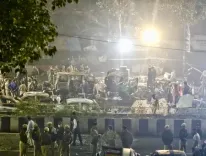Is Trump's MAGA Narrative Built on Assumptions and Exaggerations?

Synopsis
Key Takeaways
- India's rich history gives it resilience against external pressures.
- Trump's tariffs could challenge Indian labor-intensive sectors.
- Strategic autonomy is key for India's economic navigation.
- Technology and AI are pivotal for India's growth.
- Domestic reforms aim to attract foreign investment.
Washington: Donald Trump’s threat of a 50 percent tariff on India for its purchases of Russian oil is unlikely to intimidate India—a nation with a remarkable 5,000-year history that has withstood the challenges of British colonialism. Despite imposing high trade barriers, Trump has already enacted a 25 percent tariff on Indian goods. On August 6, he introduced another 25 percent tariff as India persists in acquiring Russian oil.
Trump is acutely aware of what does not resonate with India. New Delhi should remain steadfast and not take the bait. The nation’s economic landscape is sufficiently robust, with the government maintaining a firm stance on sensitive commodities such as agricultural products and dairy, including genetically modified (GM) foods. Additionally, the government prioritizes the interests of Indian consumers concerning oil procurement. Conversely, the US insists on zero-duty access to its products in India, showing reluctance to make concessions on sectoral tariffs—such as 50 percent on steel, aluminum, and copper, and 25 percent on automobiles and auto parts. Trump has leveraged punitive tariffs to secure advantageous deals.
Trump’s perplexing and authoritarian tariff strategies could adversely affect labor-intensive sectors within India’s economy, including chemicals, apparel, textiles, gems and jewelry, and footwear. The Reserve Bank of India (RBI) forecasts a 6.5 percent GDP growth for the fiscal year 2025-26. The future looks promising for agriculture and manufacturing, with investments gaining momentum. India’s strategic autonomy, along with its multi-alignment policy amidst a tumultuous global political environment, could signal an increase in domestic job opportunities through rising demand. India has a significant opportunity to reshape its economy through reforms that attract investment and position it as a competitor to China in manufacturing.
Prominent industrialist Anand Mahindra has called for a bold and strategic response from India. He has urged the government to significantly enhance its ease of doing business by implementing a comprehensive single-window clearance system for all investment proposals, which could elevate India into the top 50 and attract USD $100 billion in FDI by 2030. Prime Minister Narendra Modi’s mantra of 'first be vocal for local, then go global' is aimed at empowering small businesses to mitigate the impact of tariffs and contribute to 'Make India Great Again'. Experts suggest that there should be 100 percent FDI in sectors such as road transport, water conservation, sanitation, rural infrastructure, defense, and S&T, accompanied by complete technology transfers to generate more jobs by 2030.
Technology, particularly AI, serves as India’s secret weapon. Under PM Modi’s leadership, India has positioned itself as a global frontrunner in AI, revolutionizing its digital landscape. The government has set up four AI centers of excellence focusing on agriculture, education, healthcare, and sustainable urban development, fostering collaboration among academia, industry, and government to advance specialized AI applications. It’s crucial for India’s tech firms to boost their R&D investments to at least two percent of their revenue.
Economists warn of a potential slight downturn in India’s economic growth due to its diversified trade relationships worldwide. Currently, there is stagnation concerning significant purchases from the US, such as Stryker armored combat vehicles, Javelin anti-tank missiles, and six Boeing P8I reconnaissance aircraft along with their support systems. Defence Minister Rajnath Singh’s planned visit to the US at the end of August has also been postponed.
India has labeled Trump’s tariffs as unfair and unjustified. The US President contends that America has been a victim of the system, and the 'Make America Great Again' (MAGA) movement is effectively shaping public opinion. As of June, the dollar has been declining, marking the worst first half since Nixon’s departure from the Bretton Woods gold standard and the sudden oil crisis in 1973.
The MAGA narrative is built on a foundation of assumptions and exaggerations. Trump utilizes tariffs to motivate American taxpayers to purchase more domestic products. In the realm of Trumpism, policy often takes a back seat. Tariffs are employed as leverage against trade partners to negotiate deals favorable to the US. Indeed, the US has reportedly gained two million jobs, which are not low-wage positions typically found in fast-food establishments. Median household income in America has surged by 50 percent, and hourly wages have risen despite the challenges posed by China. The MAGA movement has proven to be an effective political strategy, prompting the American public and taxpayers to reconsider what Trump might have offered them in a potential second term.
The renewed American interest in Pakistan may be driven more by the quest for minerals and rare earths than by oil. Shockingly, Trump even had lunch with Pakistan's Chief of Army Staff, General Asim Munir, on June 18. Given the fluctuating dynamics between India and the US, Munir's inflammatory threats and nuclear saber-rattling against India, made from Trump’s home state of Florida, went uncondemned by the US administration.
(The author is a specialist in South Asian and Eurasian affairs and previously worked at the Manohar Parrikar Institute for Defence Studies and Analyses. The views expressed are strictly personal.)









